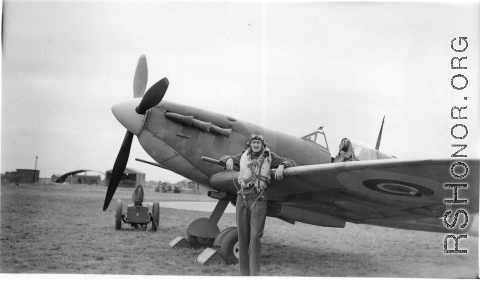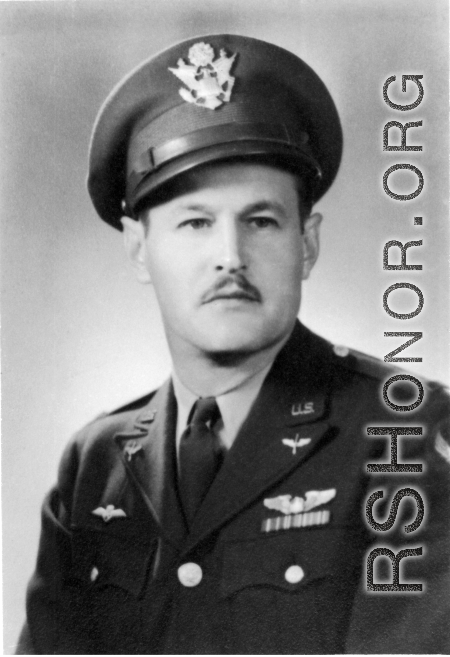1st Lt. Albert Lloyd Haynes Jr. of the 26th Fighter Squadron, 51st Fighter Group, 14th Air Force. Lt. Albert (Pappy) Haynes was a P-40 (#43-11365) pilot who was shot down and lost on July 5th, 1944 over Hengyang, Hunan Province returning from escorting B-25s after taking off from Guilin.
Albert's thoughts of flying came from his grandfather's side of the family. Granddad's brother Cornelius was an engineer for GM. In the late 20's they belonged to a flying club at Logan Field in Dundalk, MD and flew WWI surplus JN "Jenny" planes. Undoubtedly, Albert would have been around to see all of this and to inspire his young interest. (This group became the first Air National Guard unit and was activated at the beginning of WWII. )

Albert's first flight lesson took place in Norfolk on May 12, 1940, in a Piper Cub airplane.
The story of how Albert came to join the Army and become a pilot is interesting, as related to the family by Aunt Pearl, Albert's sister. In early '41 Albert decided he wanted to get into the war, this was before the US was involved. He went to Detroit and took a train into Canada to enlist in the RCAF. The first time, he was caught and told to go back to the US or risk arrest, but the second time made it through and attempted to signed. He was told he was too tall to be a pilot at 6'3'' but he took the seat cushion out of the plane and made a successful test flight. Although he had very little, if any, flight experience, he was made a pilot. Albert "Pappy" Haynes ended up as a volunteer in the Royal Canadian Air Force, where he received his commission and wings just before Pearl Harbor. He finished flight training and was sent to England were he was a member of the all American "Eagle Squadron".
Pearl said they received a letter from someone who had been on a ship during the evacuation of Dunkirk (she thought) that had somehow gotten their address and written to thank him for his actions during the evacuation. Then he served in the Royal Air Force in England for a year and a half until he was to the Army Air Force in December, 1942.
Lt. Haynes came home on leave and was the guest speaker at a War Bond rally in January, 1943. This was the last time anyone from his family saw him. In May, 1943, he was assigned to the "Asiatic theater," and first went to India, then to China. There he was the only pilot entitled to wear two sets of wings the US wings and the RCAF wings. Peggy, cousin of Albert, recalls the last time she saw him they all went out to dinner. Albert would wear his flyer's cap all bent down on the sides from wearing the headphones in the plane. This was a sign of an experienced pilot. Mom says during dinner he took a $10 bill (a lot of money at that time!) rolled it up and lit it to use to light a cigar. This must have impressed his cousin because she still remembered this years later.
Albert Haynes was known to be a bit of a character. A bit of his personality is reflected in a excerpt from Warriors Who Ride The Wind (by William F. X. Band, 1993), about Lt. Haynes who bailed out on an early mission, while Haynes was flying with the detachment out of Nanning, China, either in April or May 1944:
“On one of our missions to north Vietnam, “Pappy” Haynes had been shot down. Pappy was a tall, rangy, dark-haired man with a bristling mustache. Since he was twenty-eight years old, the appellation “Pappy,” was a natural to the rest of us, the eldest of whom was twenty-three. He had been seen to bail out and disappear in the jungle cover. As with anyone else who had been downed, we were not only concerned with his safety from the animals, tigers, etc., and aggressive natives, but concerned because his very existence in the jungle without adequate supplies and equipment was a very touchy thing.”
“A few weeks later, Les Dawson and I were stretched out near the alert shack when we began to hear sporadic gunfire coming from the river. Seizing a couple of automatic weapons we took off for the river on a run. At the river we were astonished to see a raft-like boat being poled along by five very attractive Chinese girls. In the middle of the raft, comfortably ensconced on a pile of cushions, reclined Pappy.”
“We took him and the girls to the mess hall and after lunch returned the girls to the river. A large group of us gave them a cheering send-off, amidst their giggles. Pappy told us that after being shot down he spent a few miserable days in the Vietnam jungles working his way north. Somewhere on the Chinese border he encountered a small village. On learning who he was, the villagers and the people from a neighboring village on the river to the north, feted him endlessly with dinner parties which included great quantities of rice wine. Finally, and reasonably sober, he made them understand he had to return to our airfield. Instead of accepting the four young men they offered to pole him down river, he selected the five beauties we had seen. He said the villagers thought that was totally comical and gave him and the girls a great send-off.”
Lt. Haynes served in China for eight months before his loss.
A member of the family corresponded with several people who served with Albert during the war. The family has letters from Ray Youngblood, Joe Bagio, and Don Lopez (who saw Haynes bail out), all replies from letters written asking for information on Albert. Joe relates that there were some high steaks poker games going on and Albert would get in if there was enough money to be had. He would throw down $1,000 and he never lost. There must be some truth to the story because in his effects sent back from China was over $1,000 which was sent by check to Albert's father.
During November of 2007 the Remembering Shared Honor group went to Hengyang to search for his crash site, and we discovered much about his loss, and eventually found elderly eye witnesses to his loss, and were told the exact site of his remains.
Until 2007, the site of his remains had never been located. But his family has never for a single minute forgotten.
View Albert Lloyd Haynes' Individual Deceased Personnel File (IDPF).
(Thanks to family of Lt. Haynes, and eyewitness Donald Lopez, for text, information, and images.)
